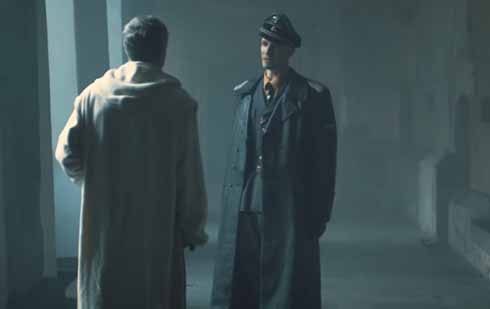 THE DAY OF WRATH (Dzien Gniewu). Starring: Radoslaw Pazura, Rafal Gasowski, Jan Marczewski, Natalia Rybicka, and Daniel Olbrychski. Directed by Jacek Raginis-Krylikiewcz. October 2020.
THE DAY OF WRATH (Dzien Gniewu). Starring: Radoslaw Pazura, Rafal Gasowski, Jan Marczewski, Natalia Rybicka, and Daniel Olbrychski. Directed by Jacek Raginis-Krylikiewcz. October 2020.
This film took out the main prize in the Best Picture category at the International Catholic Film Festival Mirabile Dictu in Rome in 2020, and has gained multiple awards at other international Festivals. The director, who is a film director, writer, playwright, poet, and teacher, was born to a religious Jewish family in Poland in 1966, and was brought up in the Jewish faith. His work expresses a keen interest in historical events and existential dilemmas.
The film itself is based on a story written by a Polish Catholic writer of Jewish origin, Roman Brandstaetter, that was dedicated to the memory of Polish martyrs who died helping Jews during the German occupation of WWII. The story was produced on stage as a theatrical play, turned into a film, and aired on Polish television. Biblical references are important to understanding the theological significance of the movie: The Book of Revelation describes the day of the Lord as an apocalyptic time of God’s almighty ‘wrath’, which comes upon those deemed to be wicked.
During the German occupation of Poland in WWII, the film shows a Polish monastery being approached by a young Jewish man (Olbrychski), who has run away from a nearby Jewish ghetto. He comes to the monastery for help. The monks know that the Nazis punish anyone with death for hiding Jews. Faced with a terrible dilemma, the Head of the Monastery, Father Prior (Pazura), offers help to the refugee. Shortly afterwards, a SS Squadron-leader (Gasowski), in charge of a death-squad responsible for the liquidation of the ghetto and the extermination campaign against the Jews, enters the monastery. He was a seminary friend of Father Prior before he embraced Jewish persecution, and is conflicted about his religious past.
The film is characterised by the complexity of moral choices, and it addresses fear, suffering and survival by the Jewish people, as well as Catholic and Judaism religious beliefs. Attracted to the writing of Brandstaetter, director Raginis-Krylikiewcz was also heavily influenced by his own experience, and arguably influenced by Carl Dreyer’s classic 1943 film, Day of Wrath which evokes the terror of Gestapo methods of torture.
Definite moral choices about life and religious faith are adopted and practiced by Father Prior, and the threat of death to self and others is an inevitable and necessary component of his decision-making. He knows some of the members of his order might wish to oppose the action he has taken in accepting the refugee into his community, and that his decision puts himself, his monks and the refugee in great peril. In coming to the right judgments about life and religious faith, the movie canvasses complex human boundaries. It argues provocatively, for instance, that motivational complexity can characterise the behaviour of victims and perpetrators.
The film is directed creatively, and Raginis-Krylikiewcz liberally uses thriller tension to drive his messages home. In the midst of gruesome events that show the horror of the Holocaust, and the tragedy of persecution, he shows an assembly of monks singing sacred music in Gregorian Chant, which offers religious judgment on what is unfolding. The device brilliantly and provocatively highlights the poignancy of what is taking place. Black and white photography starkly reinforces the drama of what is occurring, and the film is scripted outstandingly well.
This is a brilliant movie about the agony that accompanies human decision-making under stress, and the similarities and dissimilarities of religious beliefs. It tells us that moral decisiveness about the value of life can be difficult for human beings in crisis.
The acting of Pazura as Father Prior, and Olbrychski as the Jewish refugee is particularly compelling, and Raginis-Krylikiewcz’s direction is original and assured. This is an enormously powerful film with an ending that will provoke continuous religious thought. It is a film that richly deserves the many international awards it has received.
You Tube
October 2020
Peter W Sheehan is Associate of Jesuit Media